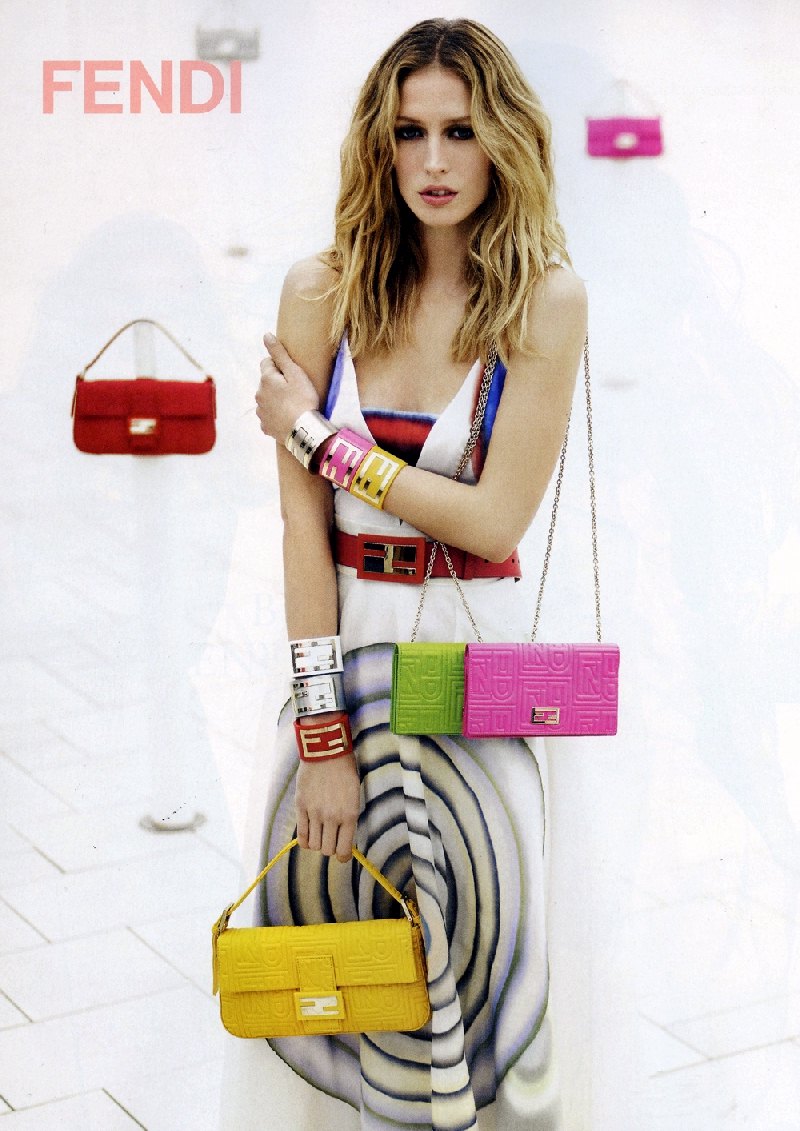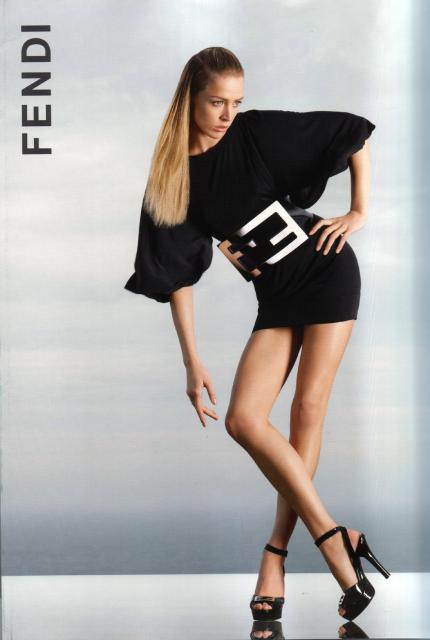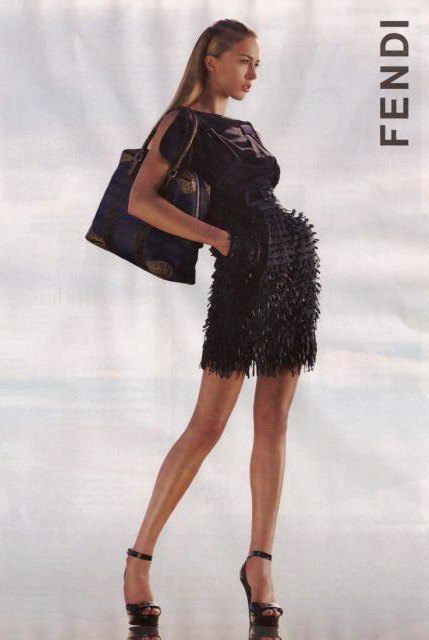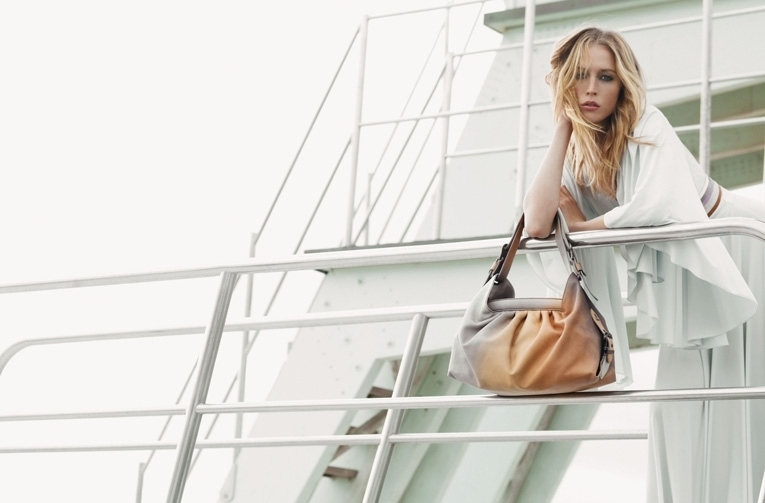| Fendi
The Fashion eZine - Fashion Brands
FendiFendi is an Italian fashion designer brand founded in 1918. Today, Fendi is owned by LVMH Moët Hennessy Louis Vuitton S.A. group, with creative director Darius at its helm. Fendi's trademark is sofas and women's clothing. 1925: Edoardo and Adele Fendi, just married, open a small leathergoods shop and fur workshop on via del Plebiscito. It’s the postwar period during which the new middle class is trying to find the way to recover. With that historical and social background the shop is an immediate success, because of the quality of the bags and the skillful workmanship of the furs. 1932: The Fendis expand and open another bigger shop and atelier on via Veneto, a residential area near via Veneto that is becoming an important commercial centre in that period. As the business is growing, the fur workshop is enlarged and the Fendi name, already famous in Rome, becomes well-known outside the boundaries of the town. The italian woman is fascinated by Fendi items, and the brand is going to become synonym of taste and style. 1946: The second Fendi generation is fatally attracted by the parents’ business. Paola, the eldest daughter, is the first one to join the company at fifteen. The four sisters follow as soon as they graduate from high school: a new entry every couple of years. It is the time in which Italy lives the frantic struggles of the post-war reconstruction. The role of women is changing in the entirely new scenary that emerges in the Fifthies and Paola, Anna, Franca, Carla and Alda, bring in new energy and new, modern ideas both for leather goods and furs. Their mother Adele encourages them, and her tenacity and personality will be a very important guide-line for their working training. 1964: Fendi is by now a well-known name in Italy. The family opens the first of several future Fendi shops on via Borgognona, which is at the time a small street of craftman. There, important names open up shops on the street and Anna Fendi creates an association of merchants (Associazione di via Borgognona, of which she is the President today) whose objective is to preserve the characteristic aspect of the road. Since many years it is considered the most elegant street in the city. 1965: This is an iportant year for Fendi that starts to work with Karl Lagerfeld, a young designer who is becoming well-known in Paris. The double FF logo is created and it has since become the symbol of a style. Interpreting the desires and suggestions of the Fendi sisters, Lagerfeld changes the whole concept of fur. What had always been a precious but stiff and heavy coat, becomes light, soft, easy to wear and suits women. The cooperation between the Fendis and Karl Lagerfeld pushes them towards the research of new materials and Paola Fendi tests new techniques. Furs that have been forgotten or put aside because considered as "poor" are used again. The workshops try tannings, colours and combinations, fur are cut, woven and inalid. Today Fendi is considered the leader brand in the fur field, because thanks to its tradition and continuous research, it has succeeded in creating a product that looks to the future without losing the important values of the past.
1966: The revolutionary methods characterizing the new fur collections are ready to be committed to the press and buyers consent: Fendi presents its first couture collection designed by Karl Lagerfeld. Success is immediate and the intrnational market starts paying attention to this new name. 1968: Following the natural expansion of the Fendi products, the Fendi bags are discovered in Rome by Marvin Traub. He is the legendary President of Bloomingdales’ and a refined talent- scout. The bags make their first appearence in New York. The same year the Fendis organize a fashion show in Japan. Mr Sakai, President of AOI (one of the leading disrtibutors in Japan of luxury items) is there to have a look. Again, it’s a "coupe de foudre". Fendi starts its expansion on the Japanese market. 1969: Fendi creates its first RTW fur collection which, when combined with craftmade workmanship, research and experience, reproduces the idea and quality of a limited- production collection. The results are as good as expected: beautiful furs at reasonable costs and retail prices. Fendi thus brings its RTW furs to Palazzo Pitti in Florence, where foreign buyers are officially introduced to the new line. Fendi strives to meet the needs of foreign markets by incorporating new ideas and suggestions received from abroad. By doing so, Fendi attracts the attention of major American stores. Leather goods and furs evolve jointly; the same ideas inspire both fur collections and leather accessories. Women’s bags become fashion items, at the same time practical and functional, and designed with the same revolutionary principles as the furs. The leather is printed, meshed tinted and tanned to become softer and more beautiful. In addition to the famous classic canvas created as an alternative to leather in 1968, Fendi introduces striped caucciÙ (ribber rubber), various waterproof fabrics, and today the traditional colours Fendi, black and mud, are reproposed in stripes, dama and regimental patterns. 1977: A second RTW line, an apparel collection, is created to complement the fashion image of discerning women who look for the same style and taste for their clothes as they do for their furs and accessories. Its success has grown steadily and, just as furs and bags, the Fendi coat or dress is immediatly recognized for its distinctive look and workmanship. 1984: As furs, leather goods and ready-to-wear are having a great success, Fendi diversifies into a series of new products and lines and accessories, successful because they are created with the same attention to detail and fashion associated with the Fendi name: jeans, gloves, ties, glasses, lighters, foulards, pens that together represent the wide Fendi world. 1985: It’s very important year in the Fendy history. It marks sixty years of business and twenty years of work together with Karl Lagerfeld. Fendi celebrates this anniversary with a special exhibition at the National Gallery of Modern Art in Rome, the first "fashion" exhibition ever presented in a national museum in Italy, illustrating the complexity of creative and technical work involved in the development of a collection. At the same time Fendi launches its first woman fragrance. 1986: The Italian President awards Paola Fendi the title of "Cavaliere del lavoro". It honours her fourty years of work in the company and it also reflects on the family, the staff, and in essence, on Edoardo and Adele. 1987: For the Fendi brand, that costantly proposes new ideas and follows the market needs, a new interesting market share is aquired: the Fendi third generation launches Fendissime, a line that includes not only furs, but also sportwear and accessories, conceived by young people for a young and less young clientele. Fendissime will grow independently from the other Fendi lines. 1989: Fendi Uomo, a man fragrance, has a worldwide launch and equals the success of the woman’s perfume. To underline its commercial success oversea, Fendi opens its forst flagship store in the United States on Fifth Avenue, New York. With a retail space of 22,000 square feet, this store offers, for the first time, the entire Fendi world under one roof. 1990: Fendi uomo menswear is launched: the man as interpreted and clothed by the five sisters. It is a complete line of menswear and accessories for every moment and circumstance in a man’s life. 1992: As the market is growing, Fendi has a logical expansion which lead to an increase in the production of Fendi goods and to the reorganization of the company premises. All the Fendi officis, creative studios, a 2000 square meters fur worshops, the showroom, the warehouses and packaging facilitites, preciously scattered in various areas of Rome, are gathered in a 13,000 sq.m. compound. 1994: It is an important year for the history both of the Fendi family and of the company. The Fendi family makes important changes in the administrative organization of the company. The third generation is admitted to the Board of Directors. As a natural turnover of power, Carla Fendi is named President of the Boards, taking the place of her sister Paola. 1995: Today the Fendi company has over 380 employees, in addition to the almost 2000 people involved in its various related activities. Roughly 70% of the overal production is geared for export. 100 boutiques, 2 direct Fendi stores in Rome and New York and 600 points of sale scattered in Italy and abroad.
Fendi AccessoriesFendissime: This "young" line (also known by Prada's Miu Miu line) was formed by Karl Lagerfeld in 1962 in cooperation with input from the five daughters. It is now discontinued. Writing Instruments: Fendi licensed their name and logo to Cross Pens in 1989. As of 2000, Cross was no longer producing writing instruments. Timepieces: Fendi currently licenses out their name for their watches, which feature Swiss movements. Fragrances: Fendi launched its first perfume, Fendi for Women, in 1985. The line has been expanded to Theorema Uomo and Fendi Uomo (for men) and Celebration and Fantasia (for women). Eyewear: Fendi's eyewear line currently includes prescription eyeglasses and sunglasses in addition to non-prescription sunglasses. The Double F Symbol: Commonly referred to as the "Zucca" print in its original form and "Zucchino" in its smaller style, Fendi's iconic "double F" logo pattern was first designed by Karl Lagerfeld in the 60's. It has been used on a variety of Fendi products, including handbags, wallets, luggage, shoes, and apparel. Kanye West once appeared at a party with the logo shaved into his head. Furs: Fendi's internationally renowned line of fur helps to differentiate the brand from its competitors as one of the few designers with a full range of fur offerings. Naomi Campbell was fired from her position as a People for the Ethical Treatment of Animals spokesperson in 1997 for wearing fur at a Fendi fashion show. Elizabeth Hurley wore a red Fendi coat in the 2000 film Bedazzled, costaring Brendan Fraser. Fendi Casa: Fendi's newest brand offering a wide variety of home furnishings. Furniture, sofas, armchairs, poufs, chaise-longues, consoles, day-beds: items of everyday life seen, interpreted, and lived with the typical Fendi style and culture. Above all this there is one common denominator: the home seen once more as the heart of a lifestyle, small pieces of furniture acting as a support for the most immediate and practical needs and more significant pieces to be personalised according to the taste. Great attention is paid to the past while tending towards the future, with considerable concern for evolution in modern design, which is interpreted, enjoyed and shared in the spirit of today’s culture. And so we find objects for the home distinguished first of all – as is the entire creation of Fendi - for their fine quality: great care and attention in the choice of fabrics and their combinations, and in the 'mix' of materials which creates new forms. All this together with the craftsmanship and attention to detail, the careful working and hand finishing, the personality which is an integral part of Fendi style. And last but not least, that creativity and imaginativeness which come from research and experiment, a mood which extends from fashion to design through the creation of personalised and personalising objects.
|
|

| |



